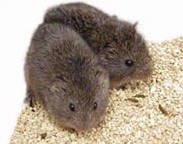Archived Content
The National Institute of Mental Health archives materials that are over 4 years old and no longer being updated. The content on this page is provided for historical reference purposes only and may not reflect current knowledge or information.
Gene Associated with Social Behavior in Animals Has Similar Effects in Human Males
• Science Update

The well-studied bonding behaviors of prairie voles (pictured above), which often mate for life, may help inform research on human bonding (Photo Credit: Larry Young, Ph.D., Emory University)

Variations in a gene may affect how men bond with their wives
A gene variant related to the hormone vasopressin appears to be associated with how human males bond with their partners or wives, according to an NIMH-funded study. In voles, a mouse-like animal, the comparable gene has been studied extensively and has long been linked to vole bonding behaviors.
This is the first study to suggest that the wealth of information on vole pair-bonding may also apply to humans and may help to inform research on human disorders related to impaired social interactions and communication, such as autism. The paper was published online on September 2, 2008, in the Proceedings of the National Academy of Sciences.
A series of studies on vole populations, begun at the NIMH Intramural Research Program in the mid-1980s by now NIMH director Thomas Insel, M.D, showed that, in male rodents, variations in a section of the gene avpr1a affect social bonding behaviors, such as choosing a mate and parenting. Recently, some research on AVPR1A* in humans suggest a possible link with autism and certain social behaviors, such as altruism, but no direct association with human pair-bonding had previously been shown.
Jenae Neiderhiser, Ph.D., of The Pennsylvania State University, and colleagues interviewed 2,186 adults taking part in the Twin and Offspring Study in Sweden (TOSS). The TOSS study collected detailed information from pairs of twins and their partners or spouses about their marital relationships, personality and mental health, and genetic data.
In humans, genetic information is stored on chromosomes, and each chromosome is made up of two parts called alleles. The researchers found that the “334” allele of a common AVPR1A variation seemed to have a negative association with men’s relationship with their spouses.
- In men, having allele 334 was inversely linked to measures of the strength of a person’s bond to their mate.
- Men who carried two copies of allele 334 were more than twice as likely (34 percent) to report serious marital or relationship problems, such as facing threat of divorce, as men who had did not carry it (15 percent)
- Men with two copies of allele 334 were almost twice as likely to be unmarried (32 percent) as men with no copies (17 percent), despite having a long term relationship with their mate
- Women married to men with one or two copies of allele 334 reported lower scores on measures of marital quality than women married to men not carrying this allele.
Allele 334 has also been shown to be associated with increased activity in the amygdala, a brain region involved in regulating emotions.
The researchers caution that their findings do not suggest this genetic variation can be used to predict an individual’s pair-bonding behavior. However, their study complements findings from similar animal research and suggests that the well-defined relationship between genes, the brain and pair-bonding behavior in voles may also be relevant for humans.
Reference
Walum H, Westberg L, Henningsson S, Neiderhiser JM, Reiss D, Igl W, Ganiban JM, Spotts EL, Pedersen NL, Eriksson E, Lichtenstein P. Genetic variation in the vasopressin receptor 1a gene (AVPR1A) associates with pair-bonding behavior in humans . Proc Natl Acad Sci USA. 2008 Sept 2 [Epub ahead of print].
*Researchers use lower-case letters to denote animal genes and upper-case letters for human genes.
